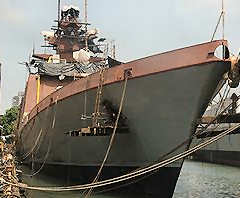
ABOVE:INS Shivalik under construction
PLEASE SEE IMPORTANT UPDATE AT THE END OF THIS POST.
The INS Shivalik, the first in the Shivalik class of stealth frigates being built by the Indian Navy, was scheduled for commissioning in April or May of this year. But the U.S. Department of State’s Directorate of Defense Trade Controls (“DDTC”) has thrown a wrench into the works, so to speak, and that commissioning may be delayed for some time.
The INS Shivalik utilizes two GE LM-2500 gas turbine engines which have already been fitted on the frigate. However, additional work needs to be performed by GE to render the engines operational. According to a report in today’s edition of India’s Business Standard, the DDTC has told GE to stop all work on the engines until the incoming administration could review its military ties with a number of nations, including India. Because this was a direct commercial sale between GE and India, a DSP-5 and a Technical Assistance Agreement (“TAA”) would already have been in place and DDTC would have therefore told GE that it was temporarily suspending the DSP-5 and the TAA.
GE told the Indian Navy that this review could take upwards of five months. This has prompted the Indian Navy to commence a search for other companies outside the U.S., such as Fiat Avio, to complete the work on the engines, according to an article in today’s Times of India. Because that might void the warranty, India is also exploring whether a foreign G.E. subsidiary could complete the work. According to the Business Standard, GE is not averse to that possibility as long as no U.S. citizens are involved in the work.
The State Department, for its part, is neither confirming nor denying that it has instructed temporary suspension of the work on the INS Shivalik according to inquiries made by the Business Standard:
The US State Department has also ignored a request for information. A spokesperson of the US Embassy in New Delhi has sidestepped the question, replying by email that, “The State Department has not instructed GE in the conduct of this direct commercial sale. Aspects of this sale were subject to export licensing, which is conducted through the State Department.†When asked to comment specifically on blanket orders from the State Department to GE regarding commercial defence dealings with India, the US Embassy did not respond.
The Obama administration’s review of its military relationship with India will no doubt be complicated by the failure of India and the U.S. to agree to the terms of a global End Use Monitoring Agreement which would permit the U.S. to monitor the deployment of defense articles exported from the United States to India. Instead, the U.S. and India have been signing individual end-use agreements for each military sale. The Indian government claims that U.S. monitoring requests are intrusive and are a violation of the country’s sovereignty, an argument that India would seem to have waived when it decided to outsource supply of military equipment from the United States.
(For those who may be wondering why I haven’t said anything yet about the DDTC’s consent decree with Analytic Methods, Inc., I plan on posting something on that tomorrow.)
UPDATE: Upon further investigation by me, I have discovered that the Indian press accounts of the situation involving the GE engines being installed in the INS Shivalik were inaccurate and that the DDTC did not stop GE’s operationalization of the engines in order to conduct a review of U.S. policy regarding defense exports to India. Apparently the engines were not modified for military use and were therefore not listed on the United States Munitions List. Accordingly, export of the engines to India did not require a license from DDTC. However, since installation of the engines on a military frigate could be construed as a “defense service,” GE delayed work on the engines pending DDTC approval of a Technical Assistance Agreement (“TAA”) allowing that work. That TAA has now been granted.
 Permalink
Permalink
Copyright © 2009 Clif Burns. All Rights Reserved.
(No republication, syndication or use permitted without my consent.)

 Posted by
Posted by  Category:
Category: 

